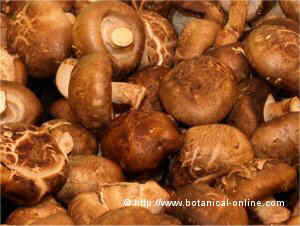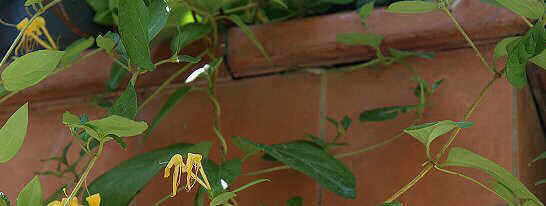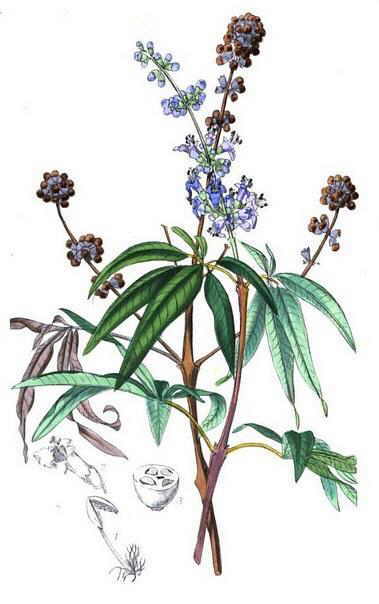Contents
- 1 Cherries as food
- 1.1 EDIBLE PROPERTIES OF CHERRIES
- 1.2 Cherry is one of the best antioxidant foods
- 1.3 Cherries protect our eyes
- 1.4 Cherries for skin health
- 1.5 BENEFITS OF CHERRIES
- 1.6 Cherries are the richest food in anthocyanins
- 1.7 The ideal fruit for cleansing diets
- 1.8 Why type of diets can cherries be good for?
- 1.9 Cherries to reinforce the bones
- 1.10 Are cherries good for cholesterol?
- 1.11 Are cherries suitable for people with diabetes?
- 1.12 What do studies on cherries for diabetes say?
- 1.13 What is the glycemic index of cherries?
- 1.14 Cherries contraindications
- 1.15 HOW TO BUY CHERRIES
- 1.16 Which are the best cherries?
- 1.17 When are cherries in season?
- 1.18 Which are the most antioxidant cherries?
- 1.19 Which cherries should we buy?
- 1.20 How to store and consume cherries?
- 1.21 Watch out for bones!
- 1.22 The cherry brandy or kirsch
- 1.23 Maraschino liqueur
- 2 Composition of cherries
Cherries as food
EDIBLE PROPERTIES OF CHERRIES
Cherry is one of the best antioxidant foods
Cherry has always been considered as one of the best fruit to cleanse the body and release toxins. The cleansing properties of this fruit derives from its wealth in anthocyanins. Anthocyanins belong to the group of flavonoids, which provide the bright colors to so many fruits.
In the case of cherries, they are responsible for the so striking red color. Anthocyanins, like other flavonoids, possess outstanding antioxidant properties capable of neutralizing free radicals that are primarily responsible for the occurrence of many degenerative diseases like arthritis, cancer or Alzheimer’s disease.
We must highlight the importance of these components in the prevention of cardiovascular diseases acquired with the aging process. This component is able to protect the heart by promoting circulation.
Cherries protect our eyes
Among the main functions of anthocyanins, is also the protection of the capillaries in the retina and, therefore, it plays a key role in the conservation of sigh, preventing such important diseases as night blindness.
Cherries for skin health
No less important is the action of anthocyanins, combined with vitamin C and amino acids, in the prevention of skin aging and nail or hair care.
These components have the ability to neutralize the action of free radicals on skin cells, so that they prevent the appearance of wrinkles, age spots, sagging and other abnormalities of the body and help us to maintain a more youthful appearance.
BENEFITS OF CHERRIES
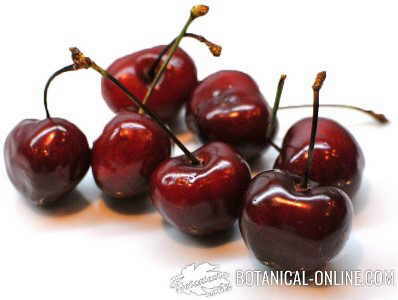 Cherriesare very rich in antioxidants
Cherriesare very rich in antioxidants
Cherries are the richest food in anthocyanins
Studies at the University of Arizona by the team of Dr. Cinthya Thomson on the composition of this fruit showed that the antioxidant capacity of the cherry is due to its high content of anthocyanins, containing much higher than other fruits that have a large reputation of containing the same principle. Cherries contain about 82 mg per cup, beating plums (12 mg per cup). raspberries (38, 7mg per cup) and black grapes (44.9 mg per cup).
Besides anthocyanins, these studies demonstrated that cherries were very rich in other antioxidant compounds such as quercetin, melatonin and other phytochemicals. Highlighting the richness of the fruit components compared with the low calorific value it provides, and recommended them to be included in the regular diet as one of the best tonics and antioxidant foods.
In fact, cherries are on the list of Food Department of the United States as one of the most powerful antioxidant food. (See main antioxidant foods)
The ideal fruit for cleansing diets
According to most food experts, consuming about 200 grams of cherries daily can help prevent or ameliorate many diseases. Equally important is their intake to maintain a youthful and healthy appearance.
Purification capacity of antioxidants combined with its wealth of water, which exceeds 80%, its lack of fat and its high content in potassium, combined with the lack of sodium makes it ideal in cleansing diets. Also helps in this regard its high content of vitamin C, a major antioxidant. Well known is the cherry diet which is based on drinking from 1 to 2 liters of cherry juice for 3 days.
These same properties make it well suited for the prevention of kidney stones or gallbladder stones.
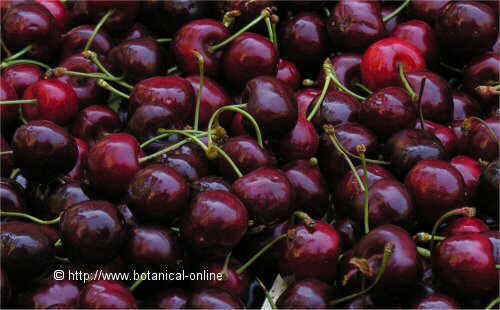 Photo of cherries. Their intense purple coloration is due to their content in vegetable pigments with antioxidant properties
Photo of cherries. Their intense purple coloration is due to their content in vegetable pigments with antioxidant properties
Why type of diets can cherries be good for?
Cherries, like any fresh fruit, are suitable and recommended in every healthy diet. They are a seasonal spring and summer food, so they will be perfect at these times of the year. It should be noted that, when providing more than 80% of water, eating fruit is a food that moisturizes us.
These type of diets cleanse the body, get rid of toxins and uric acid and help remove body fat, so it is sometimes used as a resource to lose weight on diets.
No less important are the cleansing diets for people with illnesses that require regular removal of toxins and fluids from the body to feel better.
The use of this fruit, through exclusive diets of this food or included abundantly in a liver cleansing diet, is very interesting for all people.
In this sense, cherries are very interesting for people with arthritis, gout, people with obesity or those suffering from liquid retention or cellulite.
Cherries to reinforce the bones
Moreover, given the wealth of this fruit in iron, calcium and zinc, it will help prevent or combat iron deficiency anemia (iron deficiency anemia), osteoporosis or bone thinning and other problems in the formation of bones or teeth.
Therefore, we recommend to eat cherries to women who have reached menopause, a period when which many of these anomalies usually take place.
No less important is its regular inclusion in the diet of children in regard to their growth or the health of their teeth and bones..
Are cherries good for cholesterol?
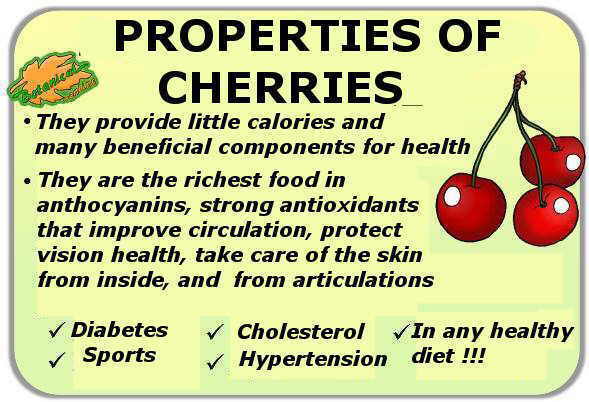 Main properties of cherries, which are the fruits richest in anthocyanins (potent antioxidants). This provides benefits for people with diabetes, cholesterol, hypertension, and in any healthy diet, in general.
Main properties of cherries, which are the fruits richest in anthocyanins (potent antioxidants). This provides benefits for people with diabetes, cholesterol, hypertension, and in any healthy diet, in general.
Cherries are fruits very rich in antioxidants that help improve the health of arteries. Anthocyanins have the property of strengthening arteries, being antioxidants and reducing inflammation.
All this makes the consumption of these fruits, as well as a diet rich in other vegetables (vegetables such as broccoli, carrots, onions, legumes, etc.) are highly recommended foods as a remedy to lower cholesterol and avoid the disease that produces tamponade of the arteries (arteriosclerosis or poor circulation).
Are cherries suitable for people with diabetes?
Cherries have traditionally been forbidden in the diet of people with diabetes. It has been defended that they are too rich in sugar and, therefore, people with this disease should not eat them.
Cherries, like other fresh fruits, are rich in carbohydrates but, like most fresh fruits, can be included, in a moderate way in the daily diet of diabetics.
What do studies on cherries for diabetes say?
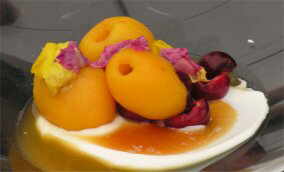 Photo of loquat with cherries and rose petals
Photo of loquat with cherries and rose petals
With regard to cherries research carried out in recent years, it seems that they have more advantages than disadvantages. A study conducted at the Cardiovascular Center at the University of Michigan by a medical team led by Seymour and Bolling, conducted on obese mice, found that animals fed on sour cherries presented at the end of this experiment lower levels of sugar in blood and a lower rate of body fat, cholesterol and triglycerides.
These researchers believed that the anthocyanins were responsible for producing these changes. They did not known whether these properties would apply to humans, although they wanted to pursue studies in people as soon as possible.
What is the glycemic index of cherries?
Eating cherries in a moderate way is suitable for diabetics, taking into account that this food is one with the lowest glycemic indexes of all fruits. Its glycemic index is 22. The glycemic index defines the speed with which sugar is poured into the bloodstream. For example, food that has a higher glycemic impact is sugar or glucose which corresponds to a rate of 100.
Soy is a food with a lower rate, as this is only 18. Mangos have an average of 55. Pears have an index of 35, which would be within the limit of which is considered low (to 50). Other fruits with low glycemic index are, for example, plums (index 24) or peaches (index 28).
Cherries contraindications
It should be borne in mind that exclusive cherry diets should not be apply to the children or the elderly. Its use is not suitable for people with kidney or liver failure.
HOW TO BUY CHERRIES
Which are the best cherries?
The best berries are those that are collected or bought ripe, since cherries do not mature well at home. If we want to eat them raw, or we want to dink their juice it is better to buy sweet cherries.
If we want to prepare cakes, pies, jams, puddings, yogurt, beer, sorbets, etc, it is better to buy sour cherries. In the market there are hybrid cherries can be used for all purposes.
When are cherries in season?
Cherries must be purchased when they are in season, That’s to say during the spring and summer.
Which are the most antioxidant cherries?
The color of sweet cherries can be red or yellow. Shades of red vary widely, from light red to red purple. The color depends on the variety, although darker ones are usually sweeter and have a higher proportion of anthocyanins. Tart cherries are usually bright red.
If we buy sweet cherries, we must choose those that are ripe but firm and with very green little tails. It is better to buy cherries from one’s country than import them. These latter contain more preservatives to preserve them during transport.
Which cherries should we buy?
Cherries with very clean and bright skin are not the most advisable in many cases . Many times they look so neat because they have been subjected to processes of embellishment to enhance its presence to increase sales. In this process, besides water, other products are used in the long run, as lacquers, polishes, waxes, etc. Some of them can be harmful
Whenever possible you should choose the better looking cherries produced in organic farming, without pesticides, fungicides, herbicides or chemical fertilizers.
How to store and consume cherries?
Whatever their origin, they need to be washed thoroughly before consumption.
They have to be stored in the refrigerator to avoid spoilage, but you should not wash them before.
They should not be put them together with other highly aromatic foods because they absorb their odors through the skin.
Watch out for bones!
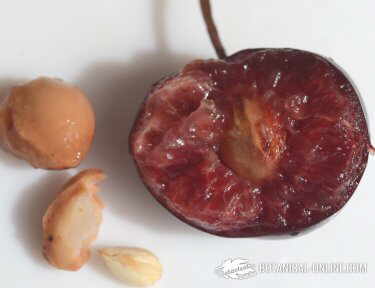 Photo of cherry split in half. A cherry is a fleshy fruit , drupe type . On the left, a whole cherry bone and one open, beneath these, a seed, creamy white, that is in the bone. This seed is very poisonous and should not be eaten.
Photo of cherry split in half. A cherry is a fleshy fruit , drupe type . On the left, a whole cherry bone and one open, beneath these, a seed, creamy white, that is in the bone. This seed is very poisonous and should not be eaten.
The bones of cherries contain within them the seeds. The seeds of cherries, as most of the seeds of the Rosaceae family, are rich in cyanogenic glycosides, some components that release cyanide, a strong poison, when ingested.
It is virtually impossible to access the seed if you do not break the bone that protects it, so that, although some bones could be swallowed, these are not digested and finally they are expelled through the feces.
However, children should warned not to break the bones to get the seeds inside them because they are toxic. As a matter of fact, it is better for you and them not to swallow the bones because they might be indigestible.
The cherry brandy or kirsch
Another question is the alcoholic preparations of these fruits.
In Germany they prepare the “Kirsch.” Its name comes from German “Kirsche” which means cherry. The real “Kirsh” is made from cherries, from wild black cherry, but can also be obtained by fermenting the juice of the sweet cherry (Prunus avium) or the sour cherry (Prunus cerasus).
This is a very aromatic alcoholic drink you can take alone or with other spirits in cocktails or your can use to flavor cakes, candies, etc. Distillation destroys toxic components, so that, made in this way, is does not offer any other toxicity in itself than that one an alcoholic beverage can present.
Formerly it was made exclusively with sour cherries and the crushed bone was included in its manufacture. Therefore, the seed was dissolved in this product, which, in small amounts as a flavoring, may not be harmful, but at higher levels it can be toxic.
Unfortunately, there are now many online recipes to prepare “Kirsch” at home that should be rejected because they include in their preparation the cherry bones crushed and macerated in alcohol for two or three weeks.
Maraschino liqueur
The Maraschino is a liqueur distilled from the Marasca cherry (Prunus cerasus var. Marasca) a type of tart cherry grown in northern Italy, Croatia, Bosnia Herzegovina and Slovenia. Crushed bones are used to make it, so the ones provide the characteristic smell of almonds. To make it sweeter you can add sugar or honey. Avoid homemade preparations. because they can contain higher doses of cherry seeds that can be toxic.
Composition of cherries
Below there is a table with the nutritional composition of cherries. As a nutritional commentary, it should be highlighted that:
- Cherries contain more than 80% water, therefore, they are foods that mainly hydrate us.
- They provide low calories, coming from carbohydrates. However, in moderation, they are an excellent food for people with diabetes, as they do not produce hyperglycemia and its antioxidants help to improve circulation.
- They are rich in fiber, excellent for people with constipation problems.
- They have no fats neither proteins.
- They are rich in vitamin C and other antioxidants (plant pigments), such as anthocyanidins. Cherries are more antioxidants by the vegetable pigments they contain than by their contribution in vitamin C, since there are other richer foods.
| Composition of raw cherries per 100 g | |
| Nutrient | CAmount |
| Water | 80,76 gr. |
| Calories | 72 Kcal |
| Fats | 0,96 gr. |
| Carbohydrates | 16,55 gr. |
| Fiber | 2,3 gr. |
| Potassium | 224 mg |
| Phosphorus | 19 mg |
| Iron | 0,20 mg |
| Sodium | 0 mg |
| Calcium | 15 mg |
| Zinc | 0,06 mg |
| Selenium | 0,6 mcg |
| Magnesium | 11 mg |
| Vitamin C | 7 mg |
| Vitamin A | 214 IU |
| Vitamin B 6 | 0,036 mg |
| Thiamin (B1) | 0,05 mg |
| Riboflavin (B2) | 0,06 mg |
| Niacin | 0,4 mg |
| Folic acid | 4 mcg |
![]() = It shows high content
= It shows high content ![]() = It shows it does not almost provide calories
= It shows it does not almost provide calories
![]() More information on cherries.
More information on cherries.


